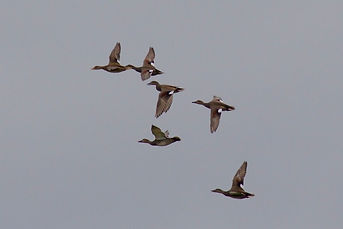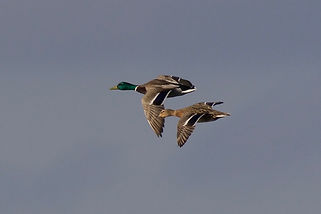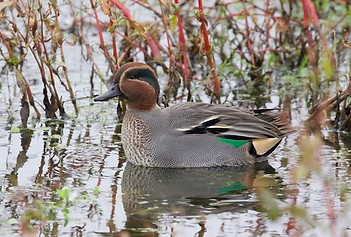
Ducks
With ducks the male is always the showier, more colourful sex. Hence the first photo of each species here is that of the male.
Like most of our waterfowl, Winter is the best time to enjoy them. They are present in greater numbers generally and supplemented by several species that only spend Winter with us. Plus they're generally in their best plumage then,

Female Mallard with ducklings
Common Scoter - A common sea duck around our coasts but not easy to get close-up views. Often form large flocks. Individuals or small flocks will very occasionally drop in on inland lakes or reservoirs for a short break on migration or respite during stormy weather.

Westport Lake, Staffs. Post breeding Migration. July

Off Flamborough Head, Yorks. September
Eider - Large, heavy sea duck. Unmistakable in appearance and their calls. That also applies to the relatively drab females, due to their distinctive, angular head and bill shape. Plentiful around the northern coastline from Cumbria right around Scotland to Northumbria. This is the duck whose feathers used to be used to make eiderdowns.





Farne Islands. May. (Female top right)
Gadwall - A fairly common and widespread duck and present year round, but easy to overlook as the males appear plain grey at distance and the females closely resemble female mallards.




Various locations. (Female top right)
Garganey - Quite a rare, timid duck. One of our smallest. The male is quite stunning when you're lucky enough to get a close view. A few are always seen on migration passage but are always a noteworthy sight.

WMBC Belvide - May

RSPB Conwy - May. (Female on right)
Goldeneye - A winter visitor to lakes and reservoirs. They are generally fairly nervous so keep well away from the edges, when people are around. The males are very striking and their golden eye and white cheek patch make them unmistakable. They show up as much whiter than similar ducks like Tufted, from a distance. They breed in trees. A few in Scotland.

Poole Harbour. February

Chasewater, Staffs. January (3 males in view)
Goosander - A large fish eating duck. Usually quite shy and easily scared away. Lie low in the water. The male develops a rosy glow to the chest when in full breeding finery.



All taken at Chasewater, Staffs. A reliable pretty place to see Goosander in Winter. Above: Female, below left: A group of males.
Long-tailed Duck - A true sea duck which rarely ventures inland. The male is particularly striking in summer plumage with very long tail feathers. A fairly small and squat duck. My only encounters have been three sightings inland, during winter. They mainly inhabit seas around the far north of England and Scotland.


Male left at Ellesmere, Shrops. Female right at WMBC Belvide, Staffs. Both in December.
Mallard - The duck everyone knows from childhood, by feeding them at their local park or canal. The males are stunning during the colder months and probably much under appreciated due to their abundance. Although they have declined in number. Regular breeders here.






1&3. Male; 2. Female; 4. Pair; 5. Male in 'eclipse' (post breeding/Summer) plumage; 6. Pair in flight; 7. A few days old duckling.

Mandarin - A small breeding population has established in recent years from a few escapees from private collections. They were originally imported from China. Hard to believe such an exotic species is actually thriving and breeding here now.


Cannop Ponds, Forest of Dean - a reliable breeding site. March. Female on right.



Left: Male in flight. Centre: Juvenile at Horn Mill Trout Farm, Rutland. Right: Pair in tree at Cannop Ponds . Mandarins nest in trees.
Red-breasted Merganser - Another of the sawbill family - fish eating species like the Goosander and Smew. All tend to be rather nervous birds. Mergansers are reasonably widespread along much of our coastline. Not often see inland. They peak in numbers in Winter. RSPB Conwy always seems to attract a small number in Winter, where I've had my closest viewings. The males are striking birds. Females can be confused with Goosander, but the latter's red head ends neatly at a border with their white neck.



Photos 1 & 3 are males, 1 taken at RSPB Conwy and 3 at Poole Harbour, both taken in February. 2 shows a female, also taken at Conwy.
Pintail - You can see from the male how they got their name. These are a large duck. The male is particularly elegant, especially close-up when you can fully appreciate the feathering on their backs. Only really seen here in the Winter months, when they are fairly widespread, but largely coastal.



Photo 2 is a female. All taken at WWT Martin Mere in February.
Pochard - A red listed species. Reasonable widespread in Winter on lakes and reservoirs. A few breed here. The males could be confused with wigeon, but wigeon males have a vertical cream stripe down their forehead. Females are a bit nondescript and can easily be overlooked. They are less numerous than males in Winter.


Female
Red-crested Pochard - An introduced species, like the Mandarin but somewhat behind in terms of establishing a thriving breeding population. Gradually getting more numerous but still a noteworthy sighting away from a handful of it's usual haunts. Males are striking, particularly in winter and spring. Known to frequent certain London parks.

Male at Attenborough Nature Reserve in Notts - May.

Female at Titchwell Marsh, Norfolk in April
Scaup - A scarcer duck than most. Can be over-looked amongst a flock of much more common Tufted Ducks. Both sexes are very similar to Tufties, but they are quite a bit larger and chunkier. The males also have silver backs whereas male tufties have black. Mainly coastal and usually seen in Winter.


Female
Shelduck - A large, very distinctive duck. Can be seen in quite large numbers in Winter, especially around our estuaries where they feed by sifting through the wet silt at low tide. A few breed here at inland lakes etc. The male has a raised section at the rear front of the bill. This swells in the breeding season and the whole bill becomes stunningly bright red.




Photo 2 is of a pair with the female in the foreground. 3. is a developed duckling.
Shoveler - Their bill is their most distinctive feature. Shoveler have large, wide bills, used for filtering out small crustacea, in the main. Look at their unique, occasional feeding habit in the bottom right photo. I watched this flock at WWT London, swirling around and around, disturbing the silt bed to bring up food.




Photo 2 is a female. 3. Two males and 4. A flock feeding by stirring up the lake sediment.
Smew - One of our rarest ducks and I would say, especially in the case of the male, most stunning and distinctive. A handful spend time here in Winter on inland lakes and reservoirs. Always a special sight but tend to be nervous and keep their distance. Juveniles and females are similar, with red heads.Quite different to the males. A fish eating 'sawbill' species, like mergansers and goosanders.
These two young males stayed at fishing pools at Holt, Worcs for a few weeks in 2018. They arrived in November in juvenile plumage and moulted into adult male plumage within days almost.



Female at WMBC Belvide, Staffs in March.
Teal - Our smallest duck. They are very numerous in winter, but not always obvious. Being so small they often rest under the banks of lakes and rivers where they can be overlooked. If spooked by a predator they can surprise you by the size of the flock that takes flight. The males are unmistakable with that broad green stripe on their heads and the lovely teal patch on the wings (see female photo).


Female shown top right


Tufted Duck - Common, year round duck which can be found on most lakes, reservoirs and rivers. Some breed here. Distinctive with the tuft of feathers on the back of their heads. Most noticably on the males. One of our smaller ducks.





Velvet Scoter - Another black sea duck, similar to Common Scoter, but with an obvious white spot near the eye. In fact individuals are often found within flocks of Common. Much rarer though. Rarely seen inland. My only sighting to date is this single female on an inland reservoir.



Female at Chasewater, Staffs. January
Wigeon - numerous and widespread in Winter, when they can form very large flocks. They make very distinctive whistling calls, almost all the time, so you know if there are wigeon on the water, even if you haven't spotted them.



